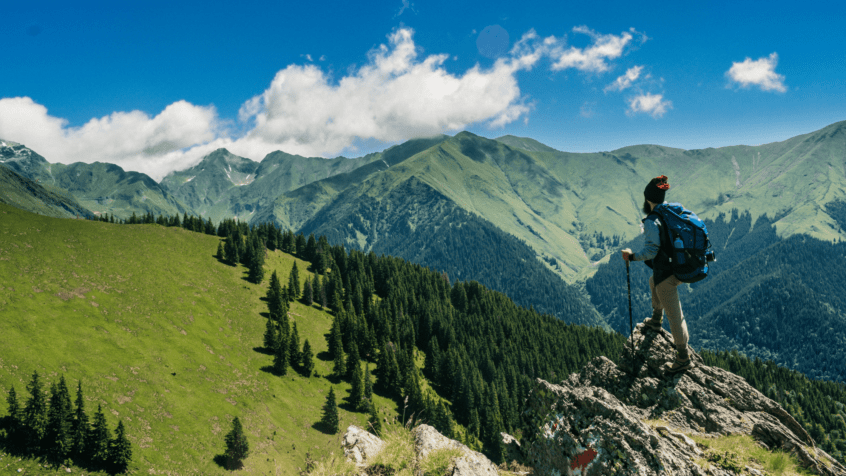Full article with thanks to: gearuphiking.com/hiking-in-bad-weather
Hiking is not only a chance for you to get some physical activity, but it’s also an opportunity to relax and unwind.
And you are probably in for one great ride – whether you decide to go hiking on your own or with a group of your closest friends.
But what happens when you wake up on a Sunday morning that was scheduled to mark the beginning of your journey only to hear the roaring sounds of thunder?
Hiking in bad weather is certainly a challenge of great proportions but it isn’t an obstacle you won’t be able to overcome.
Before you set out on your journey for the day, you first have to assess how dangerous the situation is. Will going out in the weather you are seeing the outside result in a possible injury? It goes without saying that you won’t attempt to go hiking with a hailstorm raging.
If all you are seeing is rain, then there is no need for you to cancel your plans. Assuming you have already bought a good backpack, you’ll just have to make sure you pack it with the right items.
So how does one survive a long hike in wet conditions?
Let’s find out!
#1 Check The Forecast And Be Aware Of All The Possibilities
Even though the weather forecast isn’t a bullet-proof way to predict the upcoming weather and temperatures, it will still give you an idea of what you can expect.
The first thing you need to understand is that winter wind and rain is completely different from summer showers. That’s why not all rain and bad weather bears equal importance.
If at any point you feel that the conditions are deteriorating or you simply feel exhaustion lurking, don’t hesitate to call it a day and set up your shelter.
When you are out in the wild and you are left to rely on yourself, you really have to think about safety first and foremost.
If you happen to camp in a tent for a night or two, make sure your tent is waterproof and you’re using pegs for high winds for maximum stability.
#2 Dress For The Occasion When Hiking In Bad Weather
Staying completely dry while hiking during rain for an extended period is very much impossible – that’s something you must be aware of yourself. But you can retain a reasonable level of comfort while on the trail.
If you are hiking in regions which are known for unpleasantly cold or wet weather, the best thing you can do is dress in layers. A good example of layers is:
- The base layer – a long sleeve shirt made out of Merino wool combined with comfy leggings
- The insulation layer – garments from synthetic fibers
- The outer layer – a lightweight jacket that dries quickly
- The lower body – quick drying and/or waterproof pants
And then we have the extremities – your head, feet, and hands. They are your body’s initial warning system, telling you that something is wrong.
For that reason, make sure your backpack supplies include a lightweight beanie, gloves, and Merino lined socks.
Could it be that Merino will be your best friend during this adventure? That’s something you’ll find out by yourself soon enough.
And if you’re hiking in snow, make sure to ensure your shoes are good for snow. Not all of them are! In addition, ensure that your boots are as comfortable as they can get.
As you can imagine, packing for a hike in bad weather takes some preparation. If you have decided to keep your gear in a storage unit, you first have to retrieve it, make sure everything is clean and dry, and then put it on your body or inside your backpack.
And if you are wondering what all those layers are for and why they are worth all the trouble, you are about to find out.
Last but not least, it’s a good idea to think about a waterproof backpack if you’ll be out in rain.
If it’s not waterproof at least it should be water repellent to withstand moisture for some time. Otherwise, you can get a rain cover.
Furthermore, when I hike on technical terrains, I like to wear pants with reinforced knees as an outer layer. That extra protection on the knees always comes in handy. We have a detailed list here.
In bad weather, you’d want to avoid at any cost everyday clothes such as sweatpants, for example.
#3 Avoid Sweating At All Costs
Excessive perspiration could be your number one enemy if you are not careful. It leads to a lowered body temperature which can lead to hypothermia, and that can put you in a life-threatening position.
That’s why you’ll have to monitor yourself and keep sweating in check when hiking in bad weather.
Luckily, all those aforementioned layers will help you remain nice, cool, and comfortable. Remove the layers when it becomes too hot and add them when you start feeling cold. You really are your own best friend or worst enemy in this situation.
#4 Stock Up On Food And Water
Can you imagine spending just one day on the trail without food and water? What will happen if you decide to go camping for a few days?
No matter the duration of your hike, you need to ensure you have access to hiking meals that will boost your energy.
Your backup should contain high-energy snacks that are to be taken regularly. At night and once you finish hiking for the day, consider having a meal rich in fats and proteins.
Those foods aren’t digested quickly and will keep you feeling fuller for a longer period of time.
Important notice: never forget about water when you are hiking in cold weather. You might not feel thirst but trust us – it’s there!
Dehydrated people are more susceptible to hypothermia which we already established is the last thing you want to encounter on your hike.
#5 Take Short Breaks
If you are taking a hike in bad weather, you really want to avoid being too cold or too hot. Long breaks will result in one of the two. Can you guess which one?
Of course, you might have to take a longer break at some point during your journey. For example, that’s much needed when you’re hiking with oxygen at high altitudes.
Just make sure you put on extra layers of clothing if you do. You need to do everything to make yourself feel comfortable.
Don’t forget to pack a backpacking flashlight with good brightness (at least 800 Lumens). In bad weather, visibility is often obstructed, especially at night.
Conclusion
Hiking in bad weather is definitely not an ideal scenario! You will have to overcome many obstacles, you will need to be extremely careful, and you might have to take some risks.
But at the end of the day, the most trying times usually turn out to be what shapes us into the best version of ourselves. Give yourself a chance for growth and development!
Full article with thanks to: gearuphiking.com/hiking-in-bad-weather
We offer an extensive range of adventures in the UK like our Guided Walks, Wild Camping Weekends, Guided Centre-based Walks, Backpacking Weekends, Guided Mountain Walks and much, much more! As expert adventurers, we’ve designed awesome adventure courses like Winter Hill Skills, Navigation Skills and we offer Private Courses too. Plus, we’re an accredited assessor for the Duke of Edinburgh Award Scheme and can assess Bronze, Silver and Gold Expeditions.
If you choose us for your next adventure – you’ll learn new skills and have plenty of fun!
Simply check our online calendar to book your next awesome adventure.

